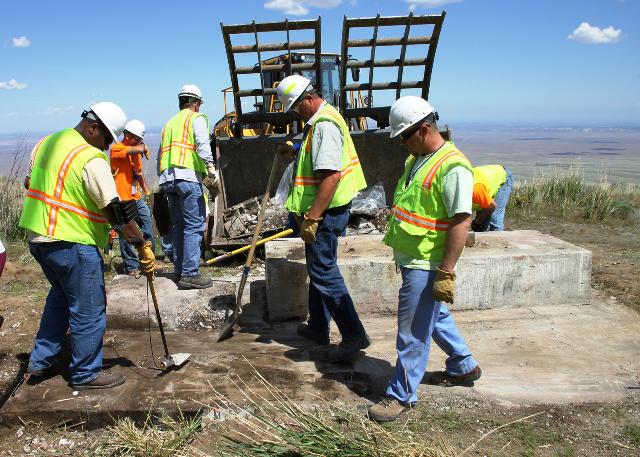
A 21-year-old who starts working at the Department of Energy’s Hanford Site in Washington state this year could have a 50-plus-year career and still retire before the former plutonium production facility is officially cleaned up.
DOE currently projects, with between 50% and 80% confidence, the Hanford Site will be deemed clean sometime between 2078 and 2091, according to a table in the DOE Office of Environmental Management budget justification for fiscal 2025.
Most of the nuclear sites managed by the $8-billion-plus DOE nuclear cleanup branch will be remediated in the 2040s, according to the summary. One of the 15, the Waste Isolation Pilot Plant (WIPP) in New Mexico does not list a completion date. Its retirement will be affected by completion of cleanup at other sites and the capacity of the underground salt mine, which in theory might change from its current statutory maximum.
Some sites list a range, between two potential completion dates. Others list only a single year. These long-term projections could be altered by funding levels, new technology or discovery of previously undocumented contamination.
Near term: The Separations Process Research Unit (SPRU) in New York state is basically cleaned up. The Moab Uranium Mill Tailings Remedial Action Project in Utah should be done by 2033.
In the 2030s: The Sandia National Laboratory in New Mexico, Lawrence Livermore National Laboratory in California and the Nevada National Security Site could all be remediated by 2035, according to the DOE table.
2040s: West Valley Demonstration Project in New York state, Los Alamos National Laboratory in New Mexico; Portsmouth Site in Ohio, Oak Ridge Site in Tennessee and the Energy Technology Engineering Center (Santa Susana Field Laboratory) in California could all be completed by 2047.
2050s and 2060s: Idaho National Laboratory and Savannah River Site in South Carolina should be remediated during the sixties.
2070: Paducah Site in Kentucky.
Late 21st century, Hanford.
Here are a few details about the sites, including dates and big jobs remaining:
The Separations Process Research Unit in New York state is finished but for fiscal year 2025, DOE’s requested $845 million within the Office of Environmental Management to safeguard the site’s transuranic waste. SPRU was home to a 1950s pilot plant used for separating plutonium from other radioactive material. It was transferred back to the DOE Office of Naval Reactors in December 2020.
The Moab Uranium Mill Tailings Remedial Action Project in Utah should be done between 2029 and 2033, according to DOE. So far, DOE has dug up 14 million of the 16 million tons of tailings at the site near the Colorado River and moved them to an engineered landfill in Crescent Junction, Utah.
Sandia National Laboratory work in New Mexico should be done in 2031, according to DOE. Contaminated groundwater remains to be addressed on Kirtland Air Force Base property near Albuquerque.
Lawrence Livermore National Laboratory in California could finish around 2033. Decommissioning and demolition of Livermore’s excess contaminated facilities started in 2018, DOE said.
Nevada Nuclear Security Site is penciled in for final remediation in 2035. Work ahead includes addressing contaminated soil from former atmospheric nuclear testing, contaminated groundwater from underground testing, and contaminated industrial sites from nuclear support services.
Portsmouth Site in Ohio should be done between 2039 and 2043. Much decommissioning and demolition remains including two remaining large process buildings that were used in uranium enrichment. One such half-mile long structure has already come down.
West Valley Demonstration Project in New York could be done in 2043. Once home to a privately-owned nuclear fuel reprocessing plant, big tasks remaining include completing the demolition of the above ground structure of the Main Plant Process Building.
Los Alamos National Laboratory in New Mexico could be done in 2044. In addition to shipping transuranic waste to WIPP, another big task is addressing an underground hexavalent chromium plume.
The Energy Technology Engineering Center site is the DOE-run portion of the sprawling, Boeing-owned Santa Susana Field Laboratory in Southern California. It should complete remediation in 2045. All DOE structures, from nuclear energy and liquid metals research have been taken down. Groundwater and soil remediation remain.
Oak Ridge Site in Tennessee should be cleaned around 2047, according to DOE. Building demolition and most remediation is already done at the former K-25 uranium enrichment plant area. Work ahead includes removing contaminated buildings, often laden with mercury, at the Oak Ridge National Laboratory and Y-12 National Security Complex.
Idaho National Laboratory lists one of the wider cleanup ranges, from 2049 to 2060. Work left includes continued transuranic waste shipments to WIPP, solidifying high-level sodium-bearing liquid waste into granular form at the Integrated Waste Treatment Unit and plans to address calcine waste.
Savannah River Site in South Carolina should finish its Office of Environmental Management mission by 2065. It continues to treat 33 million gallons of liquid radioactive waste and continues to ramp up operations of the Salt Waste Processing Facility.
Paducah Site in Kentucky should be done between 2065 and 2070. It has many of the same issues as the gaseous diffusion plant complex at the Portsmouth Site in Ohio. Like Portsmouth, Paducah has a plant to convert depleted uranium hexafluoride (DUF6) into uranium oxide, a more stable chemical form.
Hanford Site in Washington state could be cleaned up between 2078 and 2091. Hanford is DOE’s biggest environmental remediation project as the site holds about 56 million gallons of liquid radioactive waste, both high-level and low-level, left over from decades of plutonium production. In 2025, DOE is scheduled to start turning some of the less-radioactive waste into a stable glass-like form.